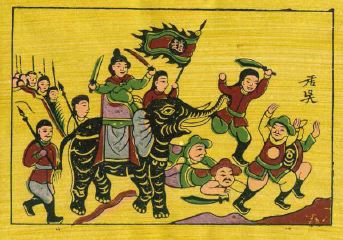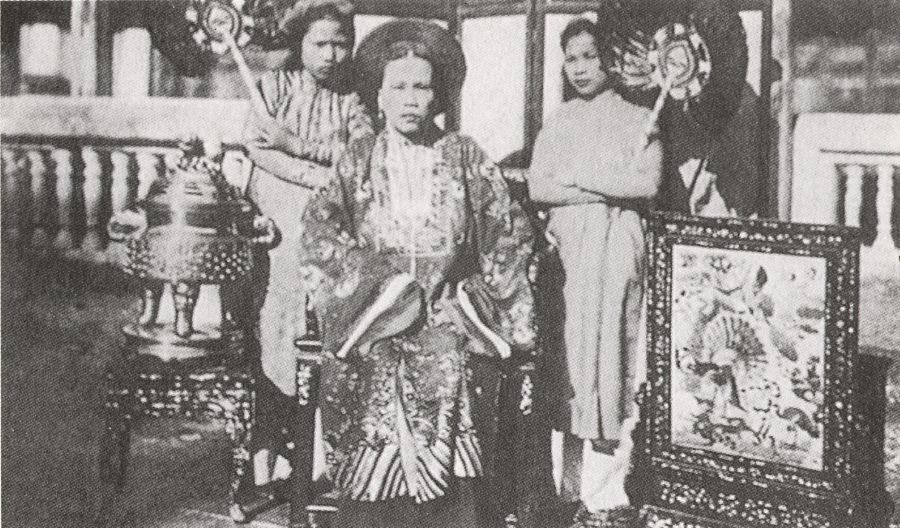 |
 |
 |
 |
 |
 |
 |
 |
 |
 |
 |
 |
 |
 |
 |
 |
 |
 |
 |
 |
 |
 |
 |
 |
 |
|
The Heroic Role of Women in Viet Nam |
|
|
|
 |
|
|
The Trung Sisters |
|
|
| Women have played a special role in the history of Viet Nam since the creation of the country itself. More than any other nation in East Asia the women of Viet Nam have often been at the forefront of the struggle for unity and independence. Their heroism have saved the country on more than one occasion and given later generations a legacy of courage for which they are still venerated in countless shrines and temples to this day. Their memory has never been forgotten and they have given courage to successive generations of Vietnamese women. |
|
|
| One of the earliest and certainly the most legendary example of this is of the heroic Trung Sisters who ruled as co-Queens of Viet Nam from 39 to 43AD. The Trung sisters, Trung Trac and Trung Nhi, were the widows of two government officials and the daughter of the beloved King Hung Vuong and his wife Man Thien. The sisters saw all of the cruelty and injustice heaped on the Vietnamese people by their Han Chinese rulers. Soon, they decided to take a stand and began to study weapons and tactics, immersing themselves in the art of war. Trung Trac eventually married Thi Sach, a skilled warrior and the son of the military governor of Chu Dien who also dreamed of a revolt against the Chinese. Because of his outspokenness the Chinese had him executed, which only infuriated Trung Trac even more against them. The Vietnamese rose up in defiance and the Trung Sisters arrayed themselves for battle. |
|
| Standing before 30,000 assembled warriors, Trung Trac said her memorable words: "Foremost, I will avenge my country, Second, I will restore the Hung lineage, Third, I will avenge the death of my husband, Lastly, I vow that these goals will be accomplished." In only a matter of months, equipped with little more than courage and a thirst for freedom, Trung Nghi and Trung Trac had captured all major citadels in the country, driven the Chinese out, liberated their country and kept the invaders away for two years. When the Chinese later returned with overwhelming numbers, the two Queens were defeated but committed suicide in the Hat Giang river rather than live under foreign domination. Their lives had ended, but their spirit and legacy was to live on forever. They are still worshiped in shrines all across the country, but most notably at the special pagodas of Hai Ba and Hat Mon. |
|
|
|
After the Trung Sisters, the most famous Vietnamese heroine to arise in the struggle for freedom was the lady Triue Trinh Nuong, or Trieu Au. She led a major revolt against the Chinese occupiers in 248 AD and later became known as the Vietnamese St Joan of Arc for her courage and devotion. Orphaned at an early age, she left for the jungle when she was only 20 to launch a crusade against the Chinese for national liberation. When her brother tried to discourage her, she boldly declared, "I want to rail against the wind, step on the ferocious tide, kill the whales at sea, sweep the whole country to save the people from slavery, and I refused to be abused". Riding an elephant, dressed in golden armor, she led an army of Vietnamese men and women against the superior forces of China. Her soldiers called her "Nhuy Kieu Tuong Quan" (The Elegant General). She fought with great courage and tenacity, but after six months her forces were wiped out by the Chinese and the tragic but heroic battle at My Hoa. Rather than live with the defeat, she also committed suicide at the age of only 23-years-old. However, she had proven to be such a fierce warrior that the Chinese were terrified by the mere mention of her name. It was widely spoken on the Chinese said that, "It would be easier to fight a tiger, than fighting the Lady Queen." |
|
 |
|
|
|
Trieu Au |
|
|
|
|
|
| There were, of course, many other women who played important roles in the history of Viet Nam. The area around the Imperial City of Hue, for example, was added to Viet Nam in 1307 when Princess Huyen Tran married the King of Champa. It was a welcome change, for this was the first time the nation had been so dramatically extended through the peaceful process of marriage diplomacy rather than through military struggle.During much of the middle period of the Nguyen Dynasty, the most powerful woman in Viet Nam was the Empress-Dowager Tu Du, who presided over the enthronement of several emperors, served as regent at the head of a secret court government and even in her old age acted as Head of State in the absence of Emperor Thanh Thai. |
|
|
| However, one of the best loved of all Vietnamese queens was the last Empress of Viet Nam, Her Majesty Nam Phuong. Jeanette Nguyen Huu Hao was favored by the Emperor Bao Dai mostly for her education and intelligent |
|
|
| conversation, though her great beauty endeared her to all of her countrymen as well. She married the Emperor on March 24, 1934 and eventually gave him two sons and three daughters, Crown Prince Bao Long, Prince Bao Thang, Princess Phuong Mai, Princess Phuong Lien and Princess Phuong Dung. Empress Nam Phuong was a patron of many charities and took a special interest in the Vietnamese Red Cross. She was also deeply involved in the efforts to rebuild and restore the country. She was loved and adored by everyone who met her, yet she was to meet an untimely death. |
|
|
 |
|
| While staying in France she was coming back from Brive when she began to feel ill in her throat. The next day, September 18, 1963, aids summoned a doctor but the Empress suffocated within the hour, before help could arrive. Doctors later believed it to be a case of angina. She was buried in Chabrignac, her life cut short. However, in the time she was known as the Empress of Viet Nam, she touched many lives and was a most beloved flower to many of her people whose lives were lifted up by her helping hand. |
|
|
|
The tradition of female service has lasted from the earliest days to modern times. Although not often remembered, the last monarch of the Ly Dynasty was a woman, the Empress Ly Chieu Hoang, who reigned for about a year until the establishment of the Tran Dynasty. Even after the fall of the monarchy in 1945, women have continued to serve and played a large part in both the northern and southern republics as illustrated by the Viet Cong leader Nguyen Thi Dinh and the famous "Dragon Lady" of Saigon, Madame Ngo Dinh Nhu. |
|
|
|
|
|
|
H.M. Empress Nam Phuong |
|
|
|
|
|
And so, we see that over the entire history of Viet Nam, through periods of war and peace, of struggle against an enemy, and struggles against subtle misfortune, the women of Viet Nam have always played a particularly prominent role and will no doubt continue to do so in the future. |
|
|
|
 |
|
|
|
Hoang Thai Hau trieu Nguyen |
|
|
| |
|







